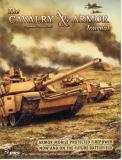The Cavalry & Armor Journal
 The U.S. Cavalry and Armor Association has been publishing the Cavalry and Journal for 125 years. In March of 1888, the U.S. Cavalry Association began publication of The Journal of the U.S. Cavalry Association at Fort Leavenworth, Kansas. This journal has recorded the step-by-step change in warfare by horse to warfare by machine. Today, the journal continues as the Cavalry & Armor Journal.
The U.S. Cavalry and Armor Association has been publishing the Cavalry and Journal for 125 years. In March of 1888, the U.S. Cavalry Association began publication of The Journal of the U.S. Cavalry Association at Fort Leavenworth, Kansas. This journal has recorded the step-by-step change in warfare by horse to warfare by machine. Today, the journal continues as the Cavalry & Armor Journal.
With the formation of the U.S. Cavalry Association in 1885 (now the U.S. Cavalry & Armor Association), article Ten of the Constitution laid the groundwork for a journal. The Association had as its mission the professional improvement and the advancement of the cavalry service. To achieve this mission, members read and discussed papers on a variety of subjects at meetings. The printed record of those papers and discussions formed the basis for the first Cavalry journal.
Volume One, Number One came off the steam press of Kecheson and Reeves at Leavenworth, Kansas, in March 1888. It was received with generous press comment from many sources, including, among others, The Epoch, The Nation, Army and Navy Journal, The Guardsman, and England's Journal of the Royal Service Institute.
The first issue of the Cavalry Journal carried a diversity of contents. Several of the subjects were of a highly controversial nature and were not resolved until many years later. The items embraced some German Ideas on Cavalry, Remounts, The New FA Gun, The Use of Arms Mounted, Sabers or Revolvers, The Kelton Devices, Marching Cavalry, MountedFire Action of Cavalry, Dismounted Service of Cavalry and, finally the French Cavalry.
In the latter pages of that first issue there appeared the Constitution and By-Laws of the Association backed by a roster of Officers of the Association and a list of members. To round out the magazine the closing pages contained a selection of military works available to members through the Association.
Early issues of the new publication were the work of a Committee on Publication and Correspondence composed of three officers. There was no Editor, as such. No schedule of publication was planned. Rather, the Journal was to be published when sufficient material had been gathered to build one issue. However, one year after the start of the publication a quarterly basis was established. This was to change periodically, for various reasons, through the years to come.
There were several difficult periods in the Journal's life. Perhaps the greatest pinch came when all officers connected with the publication were called to the front during the war with Spain. In this period only one issue was published for the years 1898 and 1899 respectively. From 1899 the lapse extended to 1902, during which period the continuation of the Journal was in great doubt. However, through the efforts of General Merritt, President of the Association, and other Association members, resumption of the publication in July 1902.
The cover of the Journal during its first several years of publication was quite plain, containing the table of contents sided by a simple sketch of guidon, bugle and saber. at the turn of the century this gave way to a somewhat stiff drawing of a mounted cavalryman. Following the difficult Spanish War period, the Journal was to undergo a real face lifting through the kindness of artist Frederic Remington, a life member of the Association.
In 1898 Remington had gone to the camp of the Third Cavalry at Tampa, Florida a friend, Captain F.H. Hardie, then commanding Troop G of the Third. While there he saw and was struck with the appearance of one of Captain Hardie's men, Sergeant Jack Lannen. Visualizing him as a perfect type of American Cavalryman, Remington made several photos inspired a finished drawing which was presented to the Cavalry Journal in 1902. In January of 1903 this sketch appeared on the cover of the Journal, where it was to remain until 1942.
In 1942, he was replaced with a photograph. This first photo was a late training shot of the Philippine Scouts. The forerunner of things to come was the Fall of '42 shot showing a view from inside a General Grant tank of armor in action on the Libyan Desert. The Association continued to use photographs on the cover until 1989. In1989 Jody Harmon's artwork would grace the cover of ARMOR and the Cavalry and Armor Journal.
World War II brought with it the final transition from horse to mechanization, and the Cavalry Journal kept pace. Articles and pictures depicted armored action. Cavalrymen underwent the transition to mechanization and armor. A traditional arm evolved a new method to acquit a traditional mission. In July of 1946 the Cavalry Association held a special Executive Session in the Editorial Office of the Journal. Resolved, that the Cavalry Association shall become the Armored Cavalry Association, and the Journal shall become The Armored Cavalry Journal.
